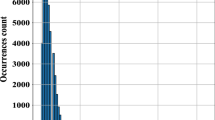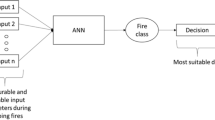Abstract
The National Fire Agency collects data such as reporting, dispatch, and suppression of fire incidents in the country every year. However, it remains at the basic level of analysis of frequency or cause of fire that occurs. In response, about 46,000 fire data throughout the country were analyzed in 2018 to predict the cause of ignition in the event of a fire. The majority of data recorded in a single fire event is unsuitable for analyzing a fire, and there is no value or data irrelevant to the cause of the fire. Thus, the data was refined to about 30,000 cases, excluding meaningless values. In addition, because it is a study to infer the unknowns of the ignition factors, data that are directly related to the ignition factors were excluded. As a result, an artificial neural network algorithm was applied to infer the ignition factors using about 10 data per fire accident, and the prediction accuracy was about 80%. Rather than determining the ignition factors through this data analysis, it is expected to provide information to fire extinguishing groups and help to increase the level of fire extinguishing. In addition, in order to use the collected data for analysis and prediction, the structure of the database needs to be improved. If the system is improved with artificial intelligence in fire inspection, it is expected that the analysis results of artificial intelligence will be provided in real time by inputting information at the site.
Access this chapter
Tax calculation will be finalised at checkout
Purchases are for personal use only
Similar content being viewed by others
References
Bae GH, Jung YH, Yoo HH (2015) A study on the trend analysis regarding the fire occurrence of Jinju City. Korean Soc Geosp Inf Sci 238–241
Seo MS, Yoo HH (2019) Spatial econometrics analysis of fire occurrence according to type of facilities. J Korean Soc Surv Geodesy Photogram Cartogr 37(3):129–141
Seo MS, Yoo HH (2020) Significance analysis of facility fires though spatial econometrics assessment. J Korean Soc Surv Geodesy Photogram Cartogr 38(3):281–293
Kim CW, Shin DG (2020) Improved classification of fire accidents and analysis of periodicity for prediction of critical fire accidents. J Korean Inst Gas 24(1):56–65
Park ES, Min SH (2019) Standardization of fire factor for big data. J Korean Soc Hazard Mitig 19(4):143–149
Park SH, Park JH, Shin DG (2020) Verification of firefighters’ heuristics through big data analysis. Korean Inst Gas 24(2):50–55
Richard Landis J, Koch GG (1977) The measurement of observer agreement for categorical data. Int Biomet Soc 33(1):159–174
Kim JS, Kim BS (2018) Analysis of fire-accident factors using big-data analysis method for construction areas. Korean Soc Civ Eng 22(5):1535–1543
Dutta R, Das A, Aryal J (2016) Big data integration shows Australian bush-fire frequency is increasing significantly. R Soc Open Sci 3:150241. https://doi.org/10.1098/rsos.150241
Lee YS, Ryu SH, Ko HA, Jeong IS (2019) A study on the standard code systematization of disaster environmental information data for earthguakes, fires and fine dusts. J Korean Geo-Environ Soc 20(12):27–32
Rajasekaran T, Sruthi J, Revathi S, Raveena N (2015) Forest fire prediction and alert system using big data technology. In: International conference on information engineering, management and security, pp 23–26
Author information
Authors and Affiliations
Corresponding author
Editor information
Editors and Affiliations
Rights and permissions
Copyright information
© 2021 The Author(s), under exclusive license to Springer Nature Switzerland AG
About this chapter
Cite this chapter
Choi, Jh., Cho, HS. (2021). Research on Predicting Ignition Factors Through Big Data Analysis of Fire Data. In: Kim, H., Lee, R. (eds) Software Engineering in IoT, Big Data, Cloud and Mobile Computing. Studies in Computational Intelligence, vol 930. Springer, Cham. https://doi.org/10.1007/978-3-030-64773-5_5
Download citation
DOI: https://doi.org/10.1007/978-3-030-64773-5_5
Published:
Publisher Name: Springer, Cham
Print ISBN: 978-3-030-64772-8
Online ISBN: 978-3-030-64773-5
eBook Packages: Intelligent Technologies and RoboticsIntelligent Technologies and Robotics (R0)




